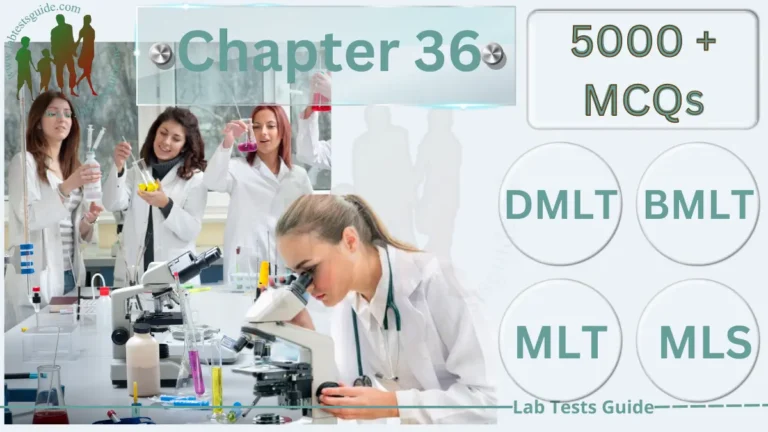4401 to 4450 MCQs for Lab Technician and Technologist Exam Preparation
5000 Plus MCQs for Lab Technician and Technologists are designed to test the knowledge and proficiency of laboratory professionals who work in the field of clinical laboratory science. These questions cover a wide range of topics related to laboratory science, including anatomy, physiology, microbiology, chemistry, and hematology.

If You like then share this to your friends and other social media.
If You have any question and suggestions then please Contact us Here
Questions 4401 to 4450
- Which test is used to evaluate the quality and fertility potential of semen?
- Semen analysis ✓
- Blood test
- Urine test
- X-ray
- Semen analysis examines which components of semen?
- Sperm count, motility, and morphology ✓
- Hormone levels
- Genetic abnormalities
- Inflammatory markers
- What is the normal range for sperm count in a semen sample?
- 0-10 million/mL
- 10-50 million/mL ✓
- 50-100 million/mL
- 100-200 million/mL
- Which parameter refers to the ability of sperm to move and swim forward?
- Sperm count
- Sperm motility ✓
- Sperm morphology
- Sperm viability
- What is the normal range for sperm motility in a semen sample?
- 0-10%
- 10-25%
- 25-50% ✓
- 50-75%
- Which term describes the size and shape of sperm?
- Sperm count
- Sperm motility
- Sperm morphology ✓
- Sperm viability
- What is the normal range for sperm morphology in a semen sample?
- 0-10%
- 10-25% ✓
- 25-50%
- 50-75%
- What is the normal pH range for semen?
- 2-4
- 4-6
- 6-8 ✓
- 8-10
- Which parameter indicates the percentage of live sperm in a semen sample?
- Sperm count
- Sperm motility
- Sperm morphology
- Sperm viability ✓
- Which of the following is NOT a component of semen analysis?
- Fructose level
- Semen volume
- Sperm DNA fragmentation
- Blood type ✓
- What is the normal range for semen volume in a sample?
- 0.5-1.0 mL
- 1.0-2.0 mL
- 2.0-4.0 mL ✓
- 4.0-6.0 mL
- Which parameter assesses the presence of white blood cells in semen?
- Sperm count
- Semen pH
- Semen viscosity
- Semen leukocyte esterase ✓
- What does the liquefaction time refer to in a semen sample?
- Time taken for semen to turn into a gel-like consistency ✓
- Time taken for semen to solidify after ejaculation
- Time taken for semen to separate into different layers
- Time taken for semen to coagulate
- Which of the following can affect semen quality?
- Smoking
- Alcohol consumption
- Obesity
- All of the above ✓
- Which infection can be detected through a semen analysis?
- Chlamydia ✓
- Influenza
- Malaria
- Tuberculosis
- Which of the following hormones is NOT typically evaluated in a semen analysis?
- Testosterone
- Follicle-stimulating hormone (FSH)
- Luteinizing hormone (LH)
- Progesterone ✓
- What is the typical duration of abstinence before providing a semen sample for analysis?
- 1-2 hours
- 6-12 hours
- 24-48 hours
- 72-96 hours ✓
- Which parameter measures the thickness of semen?
- Sperm count
- Semen pH
- Semen viscosity ✓
- Semen liquefaction time
- What is the normal range for semen viscosity?
- Watery
- Thick and gel-like ✓
- Thin and runny
- Clumpy
- Which method is used to stain and visualize sperm under a microscope?
- Hematoxylin and eosin (H&E) staining ✓
- Papanicolaou (Pap) staining
- Gram staining
- Wright staining
- What is the typical temperature range for storing a semen sample before analysis?
- Room temperature (20-25°C)
- Refrigerator temperature (2-8°C) ✓
- Freezer temperature (-20°C)
- Liquid nitrogen temperature (-196°C)
- Which condition can cause a decrease in sperm motility?
- Varicocele
- Testicular cancer
- Epididymitis
- All of the above ✓
- What is the normal range for sperm forward progression in a semen sample?
- Grade 1
- Grade 2
- Grade 3 ✓
- Grade 4
- Which test can determine if there are any sperm antibodies present in a semen sample?
- Antisperm antibody test ✓
- Polymerase chain reaction (PCR) test
- Western blot test
- ELISA test
- Which parameter indicates the presence of immature sperm cells in a semen sample?
- Sperm count
- Sperm motility
- Sperm viability
- Sperm maturity index ✓
- What does the presence of round cells in a semen sample indicate?
- Infection or inflammation ✓
- Hormonal imbalance
- Genetic abnormalities
- Poor lifestyle choices
- Which condition can cause an increase in white blood cells in semen?
- Prostatitis ✓
- BPH (Benign Prostatic Hyperplasia)
- Testicular torsion
- Peyronie’s disease
- Which parameter evaluates the presence of agglutination in a semen sample?
- Sperm count
- Sperm motility
- Sperm viability
- Sperm agglutination ✓
- What is the normal range for semen fructose levels?
- 0-5 mg/mL
- 5-10 mg/mL
- 10-20 mg/mL ✓
- 20-30 mg/mL
- Which parameter assesses the presence of red blood cells in semen?
- Sperm count
- Semen pH
- Semen viscosity
- Semen hemoglobin level ✓
- What is the normal range for semen liquefaction time?
- <5 minutes
- 5-15 minutes
- 15-30 minutes ✓
- 30 minutes
- Which condition can cause an increase in round cells in semen?
- Prostate cancer ✓
- Erectile dysfunction
- Varicocele
- Hypogonadism
- Which parameter evaluates the presence of epithelial cells in a semen sample?
- Sperm count
- Semen pH
- Semen viscosity
- Semen epithelial cells ✓
- Which parameter assesses the presence of bacteria in semen?
- Sperm count
- Semen pH
- Semen viscosity
- Semen culture ✓
- Which of the following can cause an increase in semen pH?
- Infection
- Prostate problems
- Retrograde ejaculation
- All of the above ✓
- Which parameter evaluates the presence of sperm clumping in a semen sample?
- Sperm count
- Sperm motility
- Sperm viability
- Sperm agglutination ✓
- What is the normal range for semen white blood cell count?
- 0-1 million/mL ✓
- 1-5 million/mL
- 5-10 million/mL
- 10-20 million/mL
- Which parameter assesses the presence of antibodies bound to sperm in a semen sample?
- Sperm count
- Semen pH
- Semen viscosity
- Sperm antibody test ✓
- What is the normal range for semen red blood cell count?
- 0-1 million/mL ✓
- 1-5 million/mL
- 5-10 million/mL
- 10-20 million/mL
- Which condition can cause an increase in red blood cells in semen?
- Urethritis ✓
- Testicular cancer
- Erectile dysfunction
- Hypogonadism
- Which parameter evaluates the presence of yeast or fungal infection in semen?
- Sperm count
- Semen pH
- Semen culture
- Semen yeast test ✓
- What is the normal range for semen round cell count?
- 0-1 million/mL ✓
- 1-5 million/mL
- 5-10 million/mL
- 10-20 million/mL
- Which condition can cause an increase in epithelial cells in semen?
- Prostatitis ✓
- Orchitis
- Testicular torsion
- Varicocele
- Which parameter evaluates the presence of mycoplasma or ureaplasma infection in semen?
- Sperm count
- Semen pH
- Semen culture
- Semen mycoplasma test ✓
- What is the normal range for semen epithelial cell count?
- 0-1 million/mL ✓
- 1-5 million/mL
- 5-10 million/mL
- 10-20 million/mL
- Which condition can cause an increase in epithelial cells in semen?
- Prostate cancer ✓
- Epididymitis
- Testicular cancer
- Peyronie’s disease
- Which parameter evaluates the presence of sperm DNA damage in a semen sample?
- Sperm count
- Sperm motility
- Sperm viability
- Sperm DNA fragmentation ✓
- What is the normal range for sperm DNA fragmentation in a semen sample?
- <10% ✓
- 10-25%
- 25-50%
- 50%
- Which condition can cause an increase in sperm DNA fragmentation?
- Advanced age
- Varicocele
- Smoking
- All of the above ✓
- Which parameter assesses the presence of sperm chromatin abnormalities in a semen sample?
- Sperm count
- Sperm motility
- Sperm viability
- Sperm chromatin integrity ✓
The questions are typically designed to assess the technical skills and knowledge required for the laboratory profession, including the ability to analyze laboratory test results, perform laboratory procedures, and maintain laboratory equipment.
To prepare for these MCQs, candidates should have a thorough understanding of the key concepts and principles of laboratory science. They should also be familiar with common laboratory equipment and procedures, as well as laboratory safety protocols.
Candidates may also benefit from studying specific laboratory science textbooks or taking online courses that cover the material tested in the MCQs. Additionally, practicing sample MCQs and reviewing the answers can help candidates identify areas where they may need to improve their knowledge or skills.
Overall, the MCQs for lab technologists are designed to be challenging and comprehensive, requiring candidates to demonstrate a high level of proficiency in the field of laboratory science.
Possible References Used







